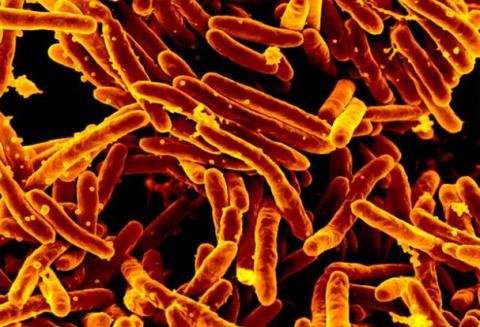Scanning electron micrograph of Mycobacterium tuberculosis bacteria, which cause tuberculosis. Credit: NIAID
Researchers at the Southwest National Primate Research Center (SNPRC) at Texas Biomedical Research Institute (Texas Biomed) may have found a new pathway to treat and control tuberculosis (TB), the disease caused by Mycobacterium tuberculosis (Mtb). Using single-cell RNA sequencing (scRNAseq), a next-generation sequencing technology, scientists were able to further define the mechanisms that lead to TB infection and latency. Co-led by Deepak Kaushal, Ph.D., Director of the SNPRC, this is the first study that used scRNAseq to study TB in macaques in depth. Results from the study were published in Cell Host & Microbe.
"Single-cell RNAseq is a novel approach that has developed in the past three or four years. It's an approach that allows us to look at the immune response more granularly, in higher resolution," Dr. Kaushal explained. "We were able to identify an immune response to Mtb infection in single lung cells as the infection progressed to disease, in some cases, or was controlled in others."
The number of TB related deaths has decreased by 30% globally. However, according to the World Health Organization, 1.4 million people died from TB in 2019; the disease continues to be one of the top communicable diseases plaguing low-income countries. It's one of several diseases negatively impacted by COVID-19 due to the virus's impact on health systems worldwide. TB is primarily spread by a cough or sneeze from someone who is infected with the disease; however, people with latent TB are not contagious. The disease is both preventable and treatable, but latent TB can become active if disrupted by another invading infection, such as Human Immunodeficiency Virus (HIV) and drug resistance continues to be a major impediment.
The study highlighted that plasmacytoid dendritic cells, which sense infection in the body, overproduce Type I interferons. Plasmacytoid dendritic cells are immune cells sent out to stop a bacteria or virus from replicating or causing disease. However, an overproduction of interferons can also cause harm. In this study, scientists observed that the interferon response correlated with disease instead of control. This information is important to scientists developing TB therapeutics and vaccines. Modifications to therapeutic/vaccine formulas may be needed to address interferon signaling.
"When we have a more precise understanding of how an infection develops, that knowledge can lead us to identify new drugs or therapies to treat disease and improve vaccines," Dr. Kaushal said. "Although our findings decreased the gap in knowledge of TB disease and latent infection, there's still more we need to learn."
More information: Ekaterina Esaulova et al. The immune landscape in tuberculosis reveals populations linked to disease and latency, Cell Host & Microbe (2020). DOI: 10.1016/j.chom.2020.11.013
Journal information: Cell Host & Microbe
Provided by Texas Biomedical Research Institute
























